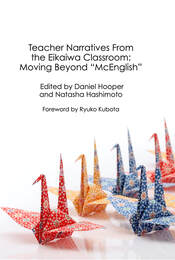Teacher Narratives from the Eikaiwa Classroom: Moving Beyond “McEnglish”
Edited by Daniel Hooper and Natasha Hashimoto [Kindle | ePub | Perlego | Print | Scribd | Apple | Proquest]
(Life and Education in Japan Series)

This book includes 16 chapters written by current and former eikaiwa (English conversation school) teachers to illustrate a complexity within the eikaiwa profession that has been thus far largely ignored. Through teacher narratives, the authors explore the unique and often problematic world of eikaiwa to present a counter narrative to what the editors regard as blanket stereotyping of a multifaceted and evolving teaching context.
Eikaiwa schools are found in virtually every city and town in Japan. They provide conversation and test-preparation classes for learners of all ages. Those attending eikaiwa may be looking to prepare for an overseas holiday or work placement, achieve a required TOEIC score for their company, or simply enjoy a new hobby and socialise with people from different cultures and backgrounds. Eikaiwa teachers often need to negotiate conflicting demands from students, parents, management, and society at large. Furthermore, opportunities for professional development are scarce and research on this context is virtually non existent. Despite the massive scale of the eikaiwa industry and the varied roles that teachers are required to fulfil within it, expatriate and ELT communities have also tended to stigmatise the work of eikaiwa teachers as being simplistic and uniform. As a result, many former eikaiwa teachers choose to “forget” their eikaiwa past and the way it shaped them as professionals. This volume provides an important opportunity for eikaiwa teachers to share their stories and for the editors to present a coherent and convincing case for the value that the experiences of working in English conversation schools has for our understanding of teaching and learning languages.
Eikaiwa schools are found in virtually every city and town in Japan. They provide conversation and test-preparation classes for learners of all ages. Those attending eikaiwa may be looking to prepare for an overseas holiday or work placement, achieve a required TOEIC score for their company, or simply enjoy a new hobby and socialise with people from different cultures and backgrounds. Eikaiwa teachers often need to negotiate conflicting demands from students, parents, management, and society at large. Furthermore, opportunities for professional development are scarce and research on this context is virtually non existent. Despite the massive scale of the eikaiwa industry and the varied roles that teachers are required to fulfil within it, expatriate and ELT communities have also tended to stigmatise the work of eikaiwa teachers as being simplistic and uniform. As a result, many former eikaiwa teachers choose to “forget” their eikaiwa past and the way it shaped them as professionals. This volume provides an important opportunity for eikaiwa teachers to share their stories and for the editors to present a coherent and convincing case for the value that the experiences of working in English conversation schools has for our understanding of teaching and learning languages.
Contents
Part 1: Getting Critical
- Chapter 2: Exploring “native speaker” framing in eikaiwa by Robert J. Lowe
- Chapter 3: Just for the casuals? Leisure and learning in eikaiwa by Daniel Hooper
- Chapter 4: Foreign enough: Migrant nonnative English-speaking teachers in eikaiwa by Natasha Hashimoto
- Chapter 5: Japan has four seasons: Nihonjinron and native-speakerisms at the eikaiwa gakkou by Martin Cater
- Chapter 6: Developmentally appropriate practices vs. parental wishes: The eikaiwa owner's quandary by Lesley Ito
- Chapter 7: Emotional labour in the eikaiwa classroom by Amelia Yarwood
- Chapter 8: Exploring the differences between eikaiwa and business English by Christopher Maschio
- Chapter 9: “Don’t repeat after me!”: The transformation of an eikaiwa by Ruth Iida
- Chapter 10: Eikaiwa vs. juku: The affordances and constraints of each context by Ewen MacDonald
- Chapter 11: The interaction of training and observation in one teacher’s development by Marc Jones
- Chapter 12: Context is everything: Qualifications, training and the myth of the untrained eikaiwa teacher by Luke Lawrence
- Chapter 13: Two narratives of professional identity in eikaiwa by Patrick Kiernan
- Chapter 14: Charisma man or critical pedagogue? Eikaiwa and unexpected paths of professional development by Kyle Nuske
- Chapter 15: Moving on: Life after eikaiwa by Andrew Boon
- Chapter 16: What can we learn from eikaiwa? Unveiling a complex and evolving entity by Daniel Hooper and Natasha Hashimoto
About the editors

Daniel Hooper has been living and teaching in Japan since 2005. He worked within the eikaiwa industry for eight years in a large chain school and in a small-family owned eikaiwa. He has worked as a full-time instructor in the English Language Institute at Kanda University of International Studies since April 2017. He received his MA TESOL from Kanda University of International Studies in 2016. His research interests are teacher and learner identity, native-speakerism, learner autonomy, and issues related to the eikaiwa industry.

Natasha Hashimoto, currently a PhD candidate at Temple University, has lived in Japan for 17 years. She worked in eikaiwa and cram schools (juku) for several years. Currently, she teaches in the English Language Department at Tokyo Woman’s Christian University. She received her master’s degree in Human Rights (research track) from Arizona State University in 2010. Her research interests include language assessment, migration, and labor and human rights issues in ELT. She won two research grants for eikaiwa research in 2017/2018.
Publication details
Publication date: February, 2020
ISBN (Print): 9798607647148
Ebook, $19.99 [available from Smashwords, Amazon Kindle, Apple, Kobo, and other ebook stores]
Print book, 204 pages, $29.99 [Available from Amazon and other online booksellers]
Series: Life and Education in Japan
Series editors: Diane Hawley Nagatomo and Melodie Cook
ISBN (Print): 9798607647148
Ebook, $19.99 [available from Smashwords, Amazon Kindle, Apple, Kobo, and other ebook stores]
Print book, 204 pages, $29.99 [Available from Amazon and other online booksellers]
Series: Life and Education in Japan
Series editors: Diane Hawley Nagatomo and Melodie Cook
